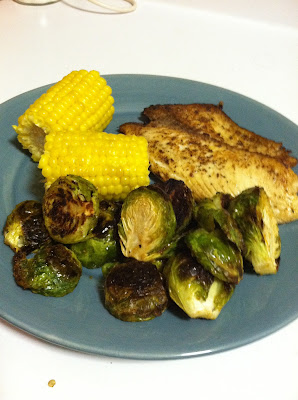Thanksgiving is definitely one of my favorite American
holidays. The table is spilling
over with scrumptious dishes, family and good friends surround me, and who
doesn’t love a couple days off from work?
I’d say the only thing missing from this almost-perfect holiday is a
green vegetable (don’t get me started on green bean casserole). I’m referring to real, whole,
un-canned vegetable goodness. I
know a lot of people who are always struggling with the vegetable component of
their meals. This explains why I
was put in charge of the vegetable side dishes for the last holiday I spent at
my parents. Vegetables are
supposed to make up half of our plate as depicted in this plate:
Unfortunately, most thanksgiving meals look like this
instead:
This holiday, let’s try to get some more nutrition on our
tables! Here are some easy recipes
for yummy healthy veggies. Happy Thanksgiving everyone!
 |
| Roasted green and white Asparagus with Dill Sauce |
Ingredients:
· 1
bunch green asparagus
· 1
bunch white asparagus
· 1 tsp
garlic powder
· salt
and pepper to taste
· extra virgin olive
oil
Directions:
Arrange all asparagus on baking pan and drizzle oil over
them. Then sprinkle with
seasoning. Roast for 8-10 minutes
at 400 degrees.
I serve the DILL SAUCE on the side as an optional
addition or you can drizzle it on top for a nice contrast to the white asparagus:
Ingredients:
· 2 T White Wine Vinegar
· 1 T Fresh Lemon Juice
· 1 T Minced Shallot
· 4 T Chopped Fresh Dill
· 1/4 tsp Kosher Salt
· 1/4 tsp Freshly Ground Black Pepper
· 1/2 Cup Extra Virgin Olive Oil
 |
|
Cider Cinnamon Brussels Sprouts
|
Ingredients:
· 1 T olive oil
· 2 cups brussel sprouts, halved
· 1 large apple, diced
· 1 large pear, diced
· 1 cup apple cider
· 1/4 teaspoon cinnamon
In a large pan over medium heat, heat oil. Cook brussel
sprouts cut side down, flipping once, until browned, 10 to 12 minutes. Add
apple and pear; cook until soft, 5 minutes. Add cider and cinnamon; simmer,
stirring, until all liquid cooks away.
Credit to epicurious.com
Credit to epicurious.com
 |
|
Savory Green Bean Sauté
|
Ingredients:
· 1
T olive oil
· 3
cloves garlic, crushed
· 1
large onion, sliced
· 4
oz mushrooms, sliced
· 1
tsp garlic powder
· 1
tsp onion powder
· salt
and pepper to taste
· 2
lbs green beans, trimmed (I prefer pre-trimmed/washed)
· 2 T soy sauce
Directions:
In a large pan over medium heat, heat oil. Sauté garlic, onion and mushrooms until
light brown. Add salt, pepper,
garlic, and onion powder.
Steam green beans separately (I put pre-trimmed green bean
bag in microwave according to instructions).
Add green beans to sauté pan with soy sauce and toss with
sautéed veggies.
***Please 'Like' me on facebook!***

















